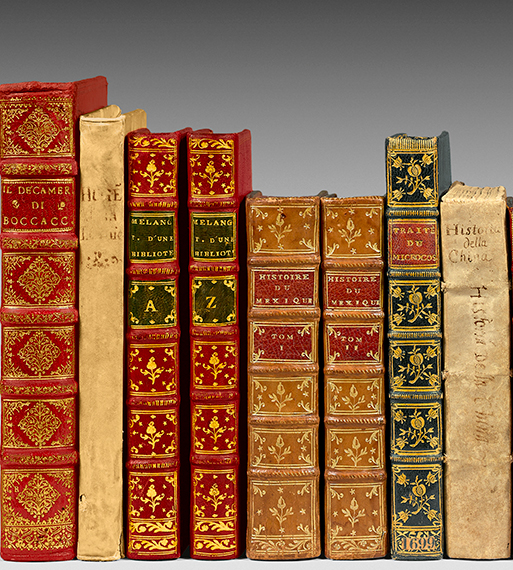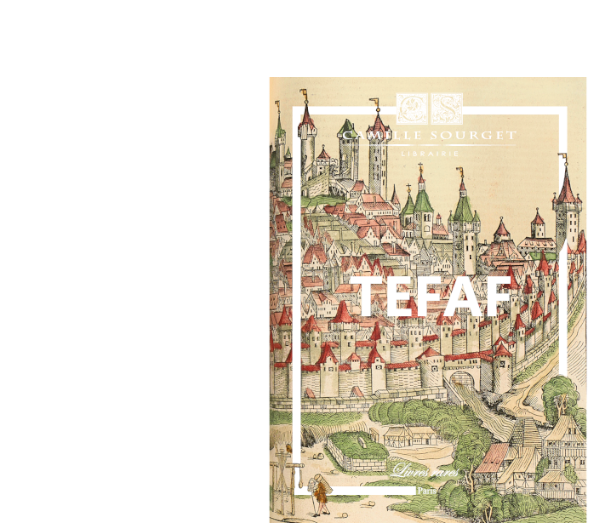Original edition of the story of Romeo and Juliet in French published in 1542.
Precious, rare, and beautiful large-margined copy of Camille Desmoulins
with a personal calligraphed bookplate.
Boccaccio, Adrian Sevin. Romeo and Juliet followed by the Philocope of Messire Jehan Boccaccio Florentin, Containing the story of Fleury and Blanchefleur, divided into 7 books translated from Italian into French by Adrian Sevin, gentleman of the House of Giè.
Paris, Gilles Corrozet, 24 February 1542.
In-folio of vi ff. and 174 ff. Brown calf, boards framed with blind fillets, spine with raised bands, decorated edges, mottled spines. Binding of the 17th century.
310 x 200 mm.
Original edition of the story of Romeo and Juliet in French and the original edition of the Philocope containing the Story of Fleury and Blanchefleur translated from Boccaccio by Adrian Sevin in 1542.
La Croix du Maine, I, p. 8 and 52; A. Cohn. “A. S.’s Work on the Saga of Romeo and Juliet” Shakespeare, Jarbuch, XXIV, 1889, p. 122 sqq; H. Hauvette, “A French Variant of the Legend of Romeo and Juliet” RLC I, 1921. P. 329spp; M. Simonin, “The Disgrace of Amadis” SF, 1982, p. 1-30. M. S.
“Adrian Sevin translator (1542) of the Philocolo of Boccaccio is the first to introduce in his dedication to Claude de Rohan, Countess of Saint-Aignan, the story of Romeo and Juliet.”
“Adrian Sevin (France) published, in 1542, a translation of Boccaccio’s Filocolo. In the preface, he included a tale inspired by Luigi da Porto’s Giulietta e Romeo, dedicated to the excellent and illustrious lady señora Claude de Rohan, Countess of Saint Aignan.
Sevin tried to disguise da Porto by moving the action to Courron, in the ancient Peloponnese peninsula. He changed Romeo to Halquadrich, son of Malchipo, and Giulietta to Burglipha, daughter of Karilio. Tebaldo became Phoraj and Pietro, Bostruch.
The only major difference from Da Porto’s work, aside from the tremendous confusion with the names, is that, at the end of the story, Burglipha takes half of the serpent’s poison that Halquadrich offers her and dies alongside him.” (Romeo and Juliet, the story through time).
“Da Porto’s novel was published posthumously at Venice without a date around the year 1530. It is essentially the familiar story, but there are variations in detail, and certain characters are missing. Romeo disguises not as a pilgrim but as a nymph; the lovers touch hands and whisper their passion in the torch-dance; the wooing and winning are not swiftly accomplished; the sentence of banishment is not pronounced until after some happy bridal days and nights have followed the secret marriage; the nurse has not yet appeared in the story; for Paris, we have here the Count of Lodrone; Juliet awakens from her drugged sleep in the tomb before the poison has entirely overwhelmed her husband’s spirit, and a dialogue ensues, the motive of which has been idealized and exalted in Gounod’s opera. This form of the tragic scene was unknown to Shakespeare, who could have imparted the beauty and dignity of passion into it; when Otway, and subsequently Garrick, with Otway as his guide, diverged from Shakespeare’s conclusion, they struck false notes and fell into the phrases of convention and pseudopathos.
Adrian Sevin’s French transformation of the story of Romeo and Juliet into the story of Halquadrich and Burglipha (1542) does take a place in the direct line of the tale’s development.”
The volume follows with the original edition of the French translation of a work by Boccaccio, the Philocope, one of the most valued love novels during the Renaissance. Two children love each other from a young age, yet everything separates them. She is a Christian of servile birth, he is a royal and Saracen. It is Love that will overcome the many obstacles this situation creates. This translation by Adrien Sevin, native of Meung-sur-Loire, based on the Italian edition of Venice 1538, is dedicated to Madame Claude de Rohan, Countess of Saint-Aignan.
Beautiful printing by Denys Janot, embellished with 36 woodcut vignettes in the text, including one in large format, remaining anonymous but attributed to Jean Cousin.
Precious large-margined copy.
Provenance: JulesClarétie (ex-dono); Camille Desmoulins (handwritten bookplate).
Manuscript ex-dono dated April 24, 1878, signed by Matton Aîné “Offered to Mr. J.Clarétie, in memory of the biography of my unfortunate relative.”

